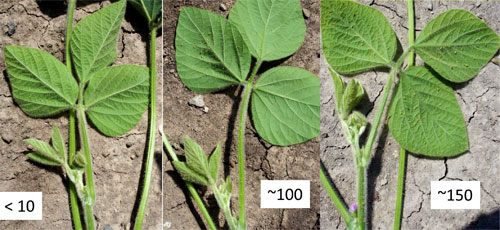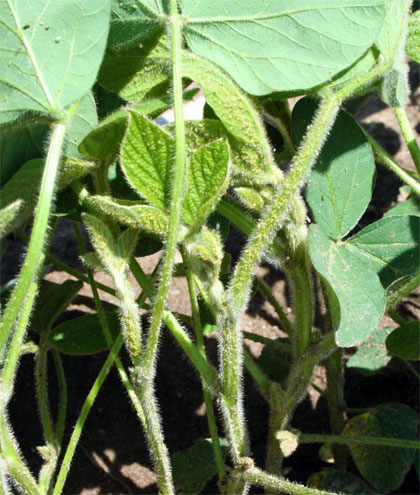Soybean aphid outbreak in Michigan’s Thumb region
For the first time since 2005, I am declaring an official soybean aphid outbreak for the Thumb, up into Bay and Arenac counties.
Aphid populations in the central and southern part of Michigan remain low with aphids limited to the new growth or an isolated, bad field. Why is the infestation focused in the Thumb?
- It is downwind (east of) the Tittabawassee River and game area, places with huge concentrations of buckthorn for overwintering.
- Fields in the Thumb were planted earlier and thus were emerged during the spring aphid flight out of buckthorn.
- For the first time since 2001, I didn't take on a graduate student to work on aphids. This pretty much guaranteed an outbreak somewhere in the state.
Observations from the Thumb
Fields planted early to mid-May without a seed treatment may be at or over threshold. I saw populations ranging from 100 to thousands per plant, probably depending on timing of initial colonization in the spring. There was also a lot of biocontrol going on out there. The infested fields will throw off winged aphids in the next few weeks. I can tell by the number of aphid nymphs with “big shoulders,” indicating that they will be winged in the final molt. Also, the aphid suction trap at the Michigan State University research farm near Frankenmuth, Mich., is catching winged soybean aphids.
Seed-treated fields planted in early and mid-May have broken, so populations are building in these fields as well as winged aphids deposit babies. This goes the same with later-planted fields that missed the initial spring flight. In addition to local sources of aphids, I would not be surprised to get an additional dump of soybean aphids carried by winds from Minnesota, Wisconsin and other points west. The good news is that we know how to kill aphids and we can do it by spraying only once.
Controlling soybean aphids
The quick version: Use the 250 soybean aphids per plant threshold, and then hit them hard and only once. Optimize coverage. Go fishing.
An expanded version:
- Spray at threshold of 250 soybean aphids per plant. It’s a good, robust threshold developed using multiple years of data from multiple states in the Midwest. The 250 threshold gives you five to seven days lead time to take action, or even to see populations drop from fungal infection or a heavy rain.
- Do not adjust the 250 threshold down. It was created in the presence of damage by other insects, like Japanese and bean leaf beetles, so it doesn't need to be adjusted for other pests. It was created with data taken during the biggest aphid outbreak years (2003, 2005), so it doesn’t have to be adjusted because it’s a “big aphid year.” Most critical, 250 is below the damage boundary – the lowest point where we can measure a yield loss. Experience shows that about 400 to 500 aphids per plant are needed before yield loss can even be detected by a yield monitor or in research trials.
- Maximize coverage in pressure and gallons per acre. A proportion of the aphid population is already on the lowest leaves of the plant and those aphids are hard to reach unless coverage is good.
- If you do decide to treat, use a full rate of a long-lasting pyrethroid or chlorpyrifos (Lorsban and generics). Do not use half rates and or a concoction of multiple products. Hit the aphids hard and only once.
- Recognize there are a lot of beneficial insects out there this year, both predators and parasitoids. Spraying kills all of these. In the Thumb, spraying may be justified, but elsewhere, many fields that had aphids two to three weeks ago now have very few aphids as predators cleaned the plants up.
Pictures of different levels of infestation can be found below and were taken July 11, 2013, at MSU farm in Saginaw, Mich.

Do not spray these low populations – no yield return + population may flare.

The photo on the left is nearing 250 soybean aphids per plant – infestation limited to top two trifoliates. The photo on the right is over 250 threshold (field average = 305 soybean aphids per plant), but not yet at economic injury level. Consider spray within five to seven. Note: beneficials, fungus or heavy rain events may still reduce the population.

Close or at the economic injury level of 600 to 700 soybean aphids per plant. Aphids on new growth + stems. There is economic return from spraying this level of infestation. Spray this type of field as soon as possible.
Dr. DiFonzo's work is funded in part by MSU's AgBioResearch.



 Print
Print Email
Email




